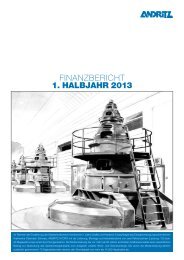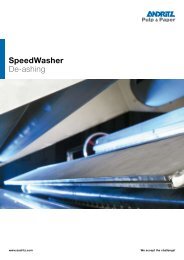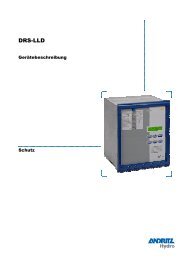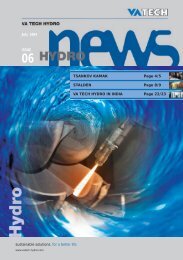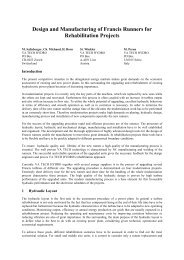May 2003 ISSUE TONGBAI Page 4/5 COMPACT HYDRO in ...
May 2003 ISSUE TONGBAI Page 4/5 COMPACT HYDRO in ...
May 2003 ISSUE TONGBAI Page 4/5 COMPACT HYDRO in ...
You also want an ePaper? Increase the reach of your titles
YUMPU automatically turns print PDFs into web optimized ePapers that Google loves.
(correspond<strong>in</strong>g to 55.6% net<br />
efficiency).<br />
The reference conditions are:<br />
• Barometric pressure 926.5 mbara<br />
• Ambient temperature 11.8°C<br />
• Relative humidity 60%<br />
The power plant is designed for a<br />
lifetime of at least 25 years and will<br />
be built to recognised <strong>in</strong>ternational<br />
standards and will also meet the local<br />
Turkish standards identified <strong>in</strong><br />
the grid code (APK359) and other<br />
relevant local legislation.<br />
Comb<strong>in</strong>ed Cycle (CC) is the technology<br />
of choice for new and<br />
replacement power plants. CC is<br />
forecast to account for over 30% of<br />
Europe's <strong>in</strong>stalled capacity by<br />
2020.<br />
Reasons <strong>in</strong>clude:<br />
• Low capital costs<br />
• High levels of generat<strong>in</strong>g efficiency<br />
(up to 56%)<br />
• Low emission levels<br />
• Short periods for erection and<br />
commission<strong>in</strong>g<br />
• Availability of low cost natural gas<br />
• Development of comb<strong>in</strong>ed cycle<br />
systems suited to baseload<br />
applications<br />
What is “Comb<strong>in</strong>ed Cycle” ?<br />
The basic pr<strong>in</strong>ciple of a comb<strong>in</strong>ed<br />
cycle power plant is the follow<strong>in</strong>g:<br />
Burn<strong>in</strong>g gas <strong>in</strong> a gas turb<strong>in</strong>e (GT)<br />
produces not only power - which can<br />
be converted to electric power by a<br />
coupled generator - but also fairly<br />
hot exhaust gases. Rout<strong>in</strong>g these<br />
gases through a boiler produces<br />
steam, which can be turned <strong>in</strong>to<br />
electric power with a coupled steam<br />
turb<strong>in</strong>e and generator.<br />
This set-up of gas turb<strong>in</strong>e, wasteheat<br />
recovery boiler, steam turb<strong>in</strong>e<br />
and generator(s) is called a<br />
comb<strong>in</strong>ed cycle.<br />
Gas Turb<strong>in</strong>e (GT)<br />
All gas turb<strong>in</strong>es operate on the pr<strong>in</strong>ciple<br />
of the Brayton cycle:<br />
Compressed air is mixed with fuel<br />
and burned under constant pressure<br />
conditions. The result<strong>in</strong>g hot<br />
gases are allowed to expand<br />
through a turb<strong>in</strong>e to produce electricity<br />
with a coupled generator.<br />
Both gas turb<strong>in</strong>es for Ankara CCPP<br />
are of the PG 9351 (FA++) type supplied<br />
by General Electric.<br />
At base load and ISO-conditions an<br />
air flow of 2,170 t/h is cleaned <strong>in</strong> a<br />
pulse type filter and compressed at<br />
a pressure ratio of 15 <strong>in</strong> an axial flow<br />
compressor (18 stages).<br />
Natural gas as fuel is added to the<br />
compressed air <strong>in</strong> the combustor<br />
and raises temperature to approx.<br />
1,290 C <strong>in</strong> a cont<strong>in</strong>uous combustion<br />
process. NOx-emissions are m<strong>in</strong>imized<br />
by a Dry Low NOx combustor<br />
(DLN 2+).<br />
In the turb<strong>in</strong>e work is extracted from<br />
the hot combustion gases as they<br />
expand to almost atmospheric pressure.<br />
This allows to drive a generator<br />
of 235 MW electrical output.<br />
The expanded gases are lead to the<br />
Heat Recovery Steam Generator<br />
(HRSG) at a temperature of approx.<br />
590°C.<br />
HRSG<br />
The waste heat available from the<br />
GT exhaust gases is utilized <strong>in</strong> two<br />
heat recovery steam generators<br />
(HRSG) of the drum type.<br />
For optimized efficiency steam is<br />
generated at three pressure levels:<br />
• High pressure (HP):<br />
120 bar / 565 °C, 320 t/h (each)<br />
• Intermediate pressure (IP):<br />
25 bar / 565 °C, 360 t/h (each)<br />
(with reheat)<br />
• Low pressure (LP):<br />
4.7 bar / 288 °C, 13 t/h (each)<br />
A supplementary fir<strong>in</strong>g system is <strong>in</strong>stalled<br />
to maximize the electrical<br />
output of the plant on demand. The<br />
temperature of the GT exhaust gases<br />
is further <strong>in</strong>creased by means of<br />
gas-fired duct burners (52.5 MW).<br />
Steam Turb<strong>in</strong>e<br />
The steam turb<strong>in</strong>e is of the 4 cas<strong>in</strong>g<br />
(2 LP cas<strong>in</strong>gs, 4 floods) type with reheat<br />
supplied by Alstom Power<br />
(Mannheim). In full condens<strong>in</strong>g<br />
mode (condenser pressure 0.035<br />
bar abs) the generator produces an<br />
electrical output of 328 MW.<br />
The nom<strong>in</strong>al live steam conditions<br />
are 120 bars, 565°C.<br />
Generators<br />
Gas turb<strong>in</strong>e generator<br />
• 2 x 276 MVA<br />
• 15.75 kV<br />
• cos phi = 0.85<br />
Steam turb<strong>in</strong>e generator<br />
• 1 x 386 MVA<br />
• 18 kV<br />
• cos phi = 0.85<br />
Cool<strong>in</strong>g Towers<br />
Cool<strong>in</strong>g water for the condenser is<br />
cooled by a mechanical draft cell<br />
cool<strong>in</strong>g tower with 16 cells by partial<br />
evaporation. The wooden cool<strong>in</strong>g<br />
tower is constructed <strong>in</strong> 2 rows, each<br />
150 m long. The circulat<strong>in</strong>g cool<strong>in</strong>g<br />
water system is equipped with 3<br />
times 50% cool<strong>in</strong>g water pumps.<br />
21







